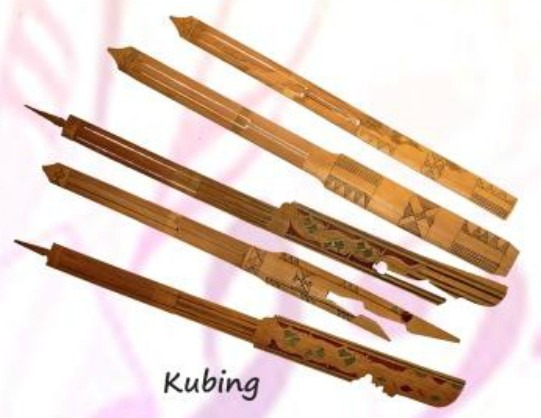The kubing is a jaw harp idiophone that is notably used by several Muslim and non-muslim tribes in the Philippines and Indonesia. This instrument is known as one of the oldest instruments in the world. The kubing is made out of a thin bamboo strip or metal strip that is about two centimeters wide.Its long-incised tongue has two sections. The wider one that is connected to the frame measures about 2.8 inches long, while the narrower one is 1.7 inches long.
Aside from its name, the kubing has also gained several names in each particular location. For instance, the Maranao people refer to it as kobing. Other tribes called it kolibau, aru-ding, kulaing, aroding, yori, karombi, or kulibaw. Meanwhile, a kubing that is made of the sugar palm leaf is referred to as karinta or ore Ngkale by the Munanese and Butonese from South-East Sulawesi. Additionally, a metal kubing was created by the people in Kalinga province, althoughthese metal kubings were rarely made nowadays.
Unlike some of the instruments used by tribes, the kubing can be used by both males and females. However, the male usually uses the kubing more for courtship. Traditionally, aside from courtship, this instrument is deemed as an intimate instrument used between loved ones, family, and close quarters for communication. Meanwhile, as a solo instrument, the kubing was played for recreation. In contemporary music, the kubing was said to be played along with the other traditional instruments in folk-ballad music.
In playing the kubing, the instrument must be held horizontally in front of the open mouth. It is played with the instrument’s outer layer facing the audience. The player should also hold the kubing firmly using the forefinger and the thumb opposing each other. But the fingers must not touch the free end of the reed. One must remember that holding the instrument more loosely will also diminish its volume. In addition to that, several varieties of sound can be made by the player if he strikes the projecting end with his index finger or thumb.
Interestingly, the kubing does not need any resonators since the player’s mouth will then serve as the resonator of the instrument. With that, a melody will be created with each opening or stopping of the glottis, as well as through the movement of the player’s mouth. Aside from the player’s mouth movement, breathing can strongly affect the sound of the kubing as well.If the player exhales during sounding, the sound and timber will also change. Moreover, one can even literally speak through the instrument with rhythmic syllables. These rhythmic syllables can be recognized and can create different tunes other than the sound made by the player’s finger strikes movement.
Although it can produce sharp plucks by releasing the frame, this action is nearly percussive. Some plucking can be done at some angles to the end, and its reed will not be driven to click against the frame. With this characteristic of kubing, the players are allowed to do multiple finger plucks a lot easier than using steel kubings. Furthermore, spreading the fingers of the plucking hand and raking them across the end will produce a succession of plucks. If a great player played the kubing, it could create a vast number of timbers and sounds.
There is no specific information regarding the origin of the kubing. However, other mouth-resonated Jew’s harps, on which the tongue is incised into the material, are mostly found in South, North, and East Asia and Oceania. Some similar instruments can also be found in European countries, but these instruments were not played like the kubing. Like its origin, it is also difficult to know the exact date that the Jew’s harp came into existence.
In fact, it is impossible to determine since it had multiple points of origin if it were to base on the distribution of the instrument. Another factor is that the kubing is made out of perishable materials. With that, the instrument doesn’t last long. What makes it more complicated is the fact that starting in the 18th century, European metal Jew’s harps were introduced to the bamboo Jew’s harps as items of trades. As a consequence, bamboo Jew’s harps in several parts of Asia and Oceania were replaced by their European counterparts.

